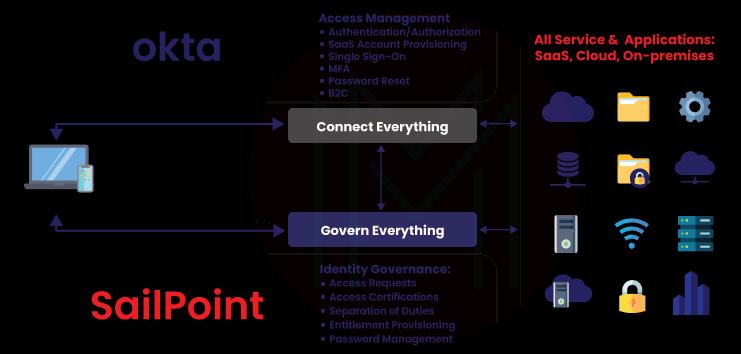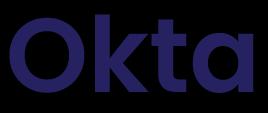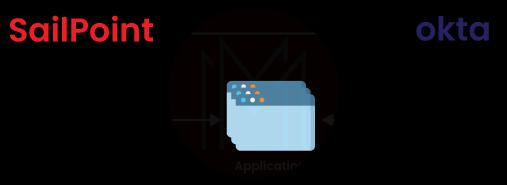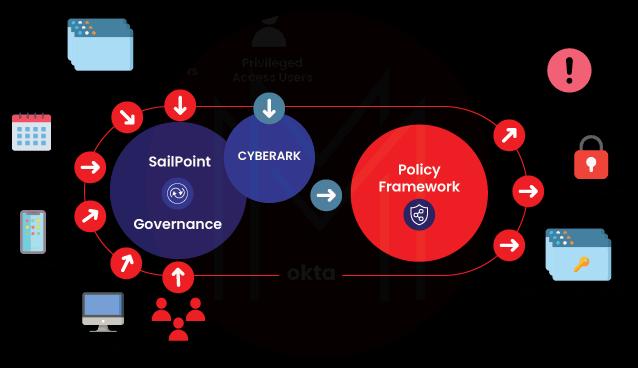Have you ever heard about OKTA and SailPoint? These are Identity and Access Management (IAM) tools for the inexperienced ones. Now, IAM is a process that helps manage user identities and access rights granted to them.
The IAM systems are generally used to control access to a specific resource. Furthermore, it also helps ensure that users only get access to such information that they need to complete their job.
In this blog, you’ll get to compare the tools - OKTA vs SailPoint and find out their differences. Lastly, know which one should be used for efficient responses. Let’s have a look ahead.

| OKTA vs SailPoint - Table of Contents |
What is OKTA?

OKTA is the cloud identity service that securely connects and provisions users to the SaaS and cloud applications as they have to do the best of their work. You can also define OKTA as the measurement unit used to describe the amount of cloud cover at a given location.
OKTA is a fundamental tool that allows users to authenticate business operations and perform various tasks, such as account verifications, multicore authentications, etc.
Furthermore, it also assists in recovering unforgotten passwords and unblocking accounts.
| If you want to enrich your career and become a professional in OKTA, then enroll in "OKTA Training". This course will help you to achieve excellence in this domain. |
What is SailPoint?

SailPoint is one identity security tool that assists your business in handling any cyber risk linked with cloud enterprises. Typically, SailPoint is an Identity Access Management (IAM) for small-size and mid-size enterprises that works to keep them safe.
Identity IQ assists in handling an extensive range of IAM processes, such as access requests, access certifications, policies, managing passwords, and more. With the SailPoint application, users can handle digital identities and make the most of other valuable features.
OKTA vs SailPoint: Advantages
To help you understand these two tools better, here are some of the advantages of OKTA and SailPoint.

| OKTA | SailPoint |
| Offers lower Table Content Objects (TCO) and higher operational efficiencies. | Offers several significant features, such as automated provisioning, user account management, role management, etc. |
| Provides improved security posture. | Designed to encompass visibility activities. |
| Supports a unified and effortless user experience. | Delivers high-level, on-premises activities and cloud-based architecture solutions to automate user access and identity management. |
| Has an accelerated path to modernization. | It has a native identity feature that is directly created in the IIQ to handle specific departments. |
| Gives secure access to resources from software devices. | It can be easily integrated with all of the systems. |
| Eradicates the passwords from the user login experience. | Is capable of automating all SaaS products. |
Differences Between OKTA and SailPoint
Jotted down below are some of the robust differences between OKTA and SailPoint. Let’s have a look:

| Factors | OKTA | SailPoint |
| Connectivity | It’s a universal directory that gets aggregated by SailPoint through an API connector. | It’s used to develop the OKTA connector, which uses application programming interfaces for groups, access information, entitlements, and synchronize users. |
| Active Directory-Based Integration | It’s connected to active directory-based integration used as a vehicle to store information about membership, groups, and users. | It’s connected to active directory-based integration where all the users and user Profiles are stored with relevant group information. |
| HRMS Integration | Helps integrate the HRMS depending on the existing deployment of customers. | All the HRMS get integrated with and connected to SailPoint. |
| Integrated with Active Directory | It can be used as an identity provider that treats the authentication sources of the active directory at runtime. | It can be integrated with the active directory through the respective agents. |
| Access Management | Helps end-users in authenticating and accessing applications. | Helps in authenticating group activities and users’ information. |
| Life Cycle Management | Helps implement the life cycle dependent on users and group information. | It helps implement the life cycle depending on the systems and the applications. |
| Users | It is best for 500 - 1000+ users as it provides a cloud-based platform. | It is adequate for more than 1000 users as it provides an identity platform. |
| Features |
Provides:
|
Provides:
|
| Support & Deployment | Offers SaaS, web-based, and cloud deployment can be used in mobile services, like iPad, iPhone, and Android. | Offers SaaS, web-based, and cloud deployment can be used in mobile services, like iPad, iPhone, and Android. |
OKTA vs SailPoint: Which One Is the Best
When choosing one from OKTA vs SailPoint, know that the former is more popular than the latter because of cost-effectiveness. Also, SailPoint is only used by large companies.
Thus, OKTA is a better and more effective tool to use as:
- It Offers a comprehensive identity management solution, such as improved security and compliance and integration with more than 5000 cloud applications.
- Can work on mobile, on-premises, and clouds.
- Has more than 3100 customers from 185+ countries, belonging to various domains, such as NASDAQ, Experian, Adobe, Century Fox, etc.
- Has been recognized by Gartner as a visionary and a leader in industry management.
| Related Article : SailPoint vs CyberArk |
Wrapping Up
Now that you have understood the difference between OKTA and SailPoint, it’s time to choose. Navigate through the features, advantages, and disadvantages of both the tools and find out which one suits your requirements. Also, before moving ahead, it’s better that you zero down on your own needs and requirements to make a better decision.
 On-Job Support Service
On-Job Support Service
Online Work Support for your on-job roles.

Our work-support plans provide precise options as per your project tasks. Whether you are a newbie or an experienced professional seeking assistance in completing project tasks, we are here with the following plans to meet your custom needs:
- Pay Per Hour
- Pay Per Week
- Monthly
| Name | Dates | |
|---|---|---|
| OKTA Training | Dec 27 to Jan 11 | View Details |
| OKTA Training | Dec 30 to Jan 14 | View Details |
| OKTA Training | Jan 03 to Jan 18 | View Details |
| OKTA Training | Jan 06 to Jan 21 | View Details |

Madhuri is a Senior Content Creator at MindMajix. She has written about a range of different topics on various technologies, which include, Splunk, Tensorflow, Selenium, and CEH. She spends most of her time researching on technology, and startups. Connect with her via LinkedIn and Twitter .




